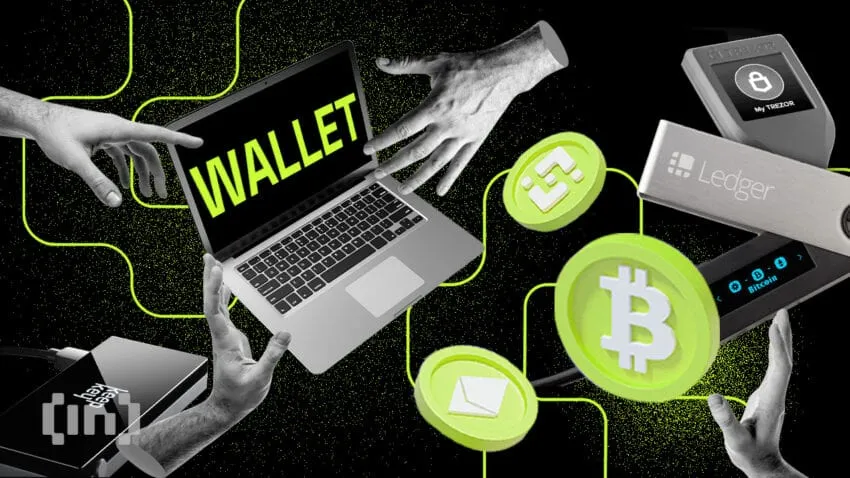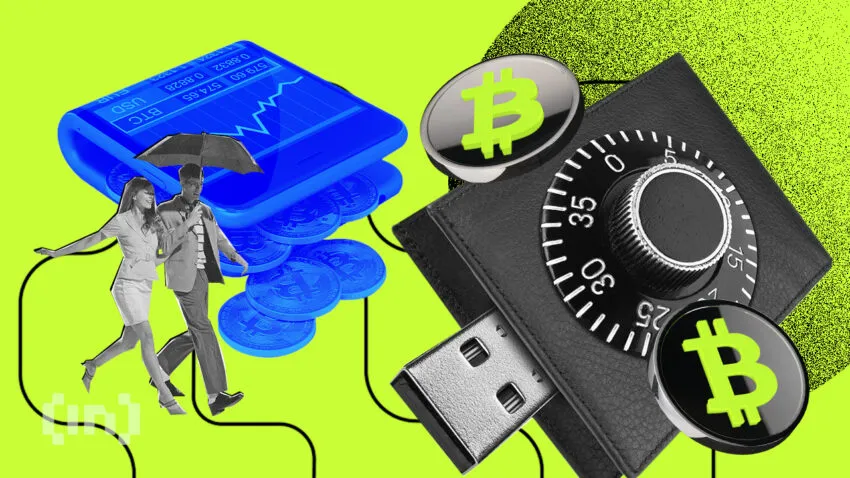As a cryptocurrency holder, you may have concerns about your digital assets’ security and access should you lose your private keys. Multisig wallets eliminate the single point of failure associated with traditional single-key wallets to ease such concerns.
In this guide, we will explain what multisig wallets are, discuss the upsides and downsides of multisig wallets, and provide a list of use cases where using multisig makes sense.
- What is a Multisig Wallet?
- How does multisig work?
- Advantages of multisig wallets
- Disadvantages of multisig wallets
- Use cases for multisig wallets
- Multisig wallet examples
- Multisig vs. single-signature wallets
- Potential security vulnerabilities and considerations
- Multisig wallets offer a more secure future
- Frequently asked questions
What is a Multisig Wallet?

A multi-signature (or multisig) wallet offers the option of multiple private keys to access your cryptocurrency or make transfers. During set-up, the parties set the access rules, including the required minimum number of keys for the execution of a task.
Multisig wallets offer a form of multi-factor authentication that increases the funds’ security. For crypto assets that belong to multiple parties, such as decentralized autonomous organizations (DAOs), the wallets ensure access can only be successful when multiple key holders are involved.
The most common multisig wallets involve three private keys with access requiring a minimum of 2 keys. The chances of losing your bitcoin forever are minimized since losing one private key still leaves you with two more. You can still access your crypto assets with the remaining two keys stored separately.
How does multisig work?
Multisig wallets require two or more signatures from a set of predetermined addresses for the execution of a transaction. There are two main types of wallets:
- All private keys required: If a wallet’s predetermined number of signatories is three, then all three keys are required for the transaction validation.
- Threshold signatures: During set-up, the holder(s) can specify the threshold required. The most common ones are two out of three and three out of five.
Multisig wallets utilize the code of smart contracts for on-chain governance. This is a departure from the traditional wallets’ format of endpoints under the control of the users.
With ongoing concerns about crypto wallet security, the working modalities of multisig wallets offer self-custody options.
“When you sign on the dotted line or accept the terms of service, you are generally agreeing that placing your tokens with these providers may mean transferring your ownership to them. There’s an expression … “not your keys, not your crypto.”
SEC Chairman Gary Gensler
The “not your keys, not your crypto” mantra advocates for self-custody to ensure you have full control of your assets. You can move your assets without requiring permission and do not have to worry about third-party actions that may put your holdings at risk.
In need of a reliable crypto wallet? Get the Coinbase wallet today!
Advantages of multisig wallets
Users can derive various benefits from using multisig wallets.
Decentralized access
Multisig wallets eliminate the single signature risk of having a key person controlling digital assets’ access. The most famous case of this risk is the QuadrigaCX saga that saw the company lose access to over $145 million of customer deposits. The company’s CEO was the only party with access to the various crypto assets in cold storage. After his death, the company lost its customers’ assets forever.
With multisig wallets, assets don’t have to be lost forever, even if one person loses their key and all recovery mechanisms fail. Access is still possible through the remaining private keys.
In other cases, shared access can minimize the chances of an exit scam since it would require coordination between multiple parties. This offers a way to reduce security vulnerabilities for companies or DAOs that wish to minimize the risk of bad actors taking advantage of their access.
Transparency
The open-source nature of the smart contracts that govern multisig wallets enhances transparency. Individuals can audit the code to understand the parties controlling the funds.
Groups can entrust key holders to control their crypto assets. They can then audit the smart contract periodically for safety and security assurances.
Adaptability
The smart contract aspect of a multisig wallet allows its adaptation to meet the users’ needs. If those needs change, the parties can adjust or upgrade the wallet.
The wallet allows developers to create models and protocols for actions such as digital assets management and voting in DAOs. The community gets to adapt the wallet to suit their changing needs instead of using different wallets with each change.
Disadvantages of multisig wallets
While their benefits do stand out, multisig wallets have various disadvantages.
Speed
For threshold signature wallets, multiple signatures appear on the blockchain as a single signature. Consequently, the transaction size increases, and miners tend to avoid such transactions. The result is higher gas fees and processing delays.
Additionally, the volatile nature of the cryptocurrency industry rewards those who take fast, strategic action in some situations. Multisig wallets require multiple parties’ coordination, which may not always be convenient.
Lack of a legal custodian
With access and control divided among multiple parties, any conflict may bring up issues that might prove challenging to disentangle. Those who may wish to seek legal assistance are bound to face challenges in establishing their standing to make any claims.
Technical knowledge
Most multisig wallet providers strive to offer users the information needed for decision-making. However, the technical details of setting up a wallet and choosing the most ideal options may be challenging to some users. As there is no one-size-fits-all solution, users need the technical knowledge to understand the options available and compare that to their needs to find the right fit.
Use cases for multisig wallets

In the recent past, various exchanges have collapsed for many reasons. Additionally, governments have stepped up their cryptocurrency regulation activities with investigations of top crypto exchanges. Multisig wallets offer an alternative to this prevalent challenge and various use cases.
Decentralized finance (DeFi)
At the core of decentralized finance (DeFi) is the utilization of peer-to-peer networks without the involvement of intermediaries. Multisig wallets allow cryptocurrency owners to lend, borrow, and trade through collective decision-making that does not necessarily involve third parties.
The consensus mechanism ensures that all, or the predetermined majority of the key holders, are involved in any transaction. This eliminates any issues associated with centralized finance, such as exchanges limiting withdrawals or malicious parties executing a rug pull.
Get the Binance Chain wallet for all of your DeFi needs. Try it today!
Business and institutional use
Businesses and institutions must manage key person risk where an individual enjoys access and control of all crypto assets. The pseudonymous nature of the crypto industry makes it challenging to build trust among business partners.
With multisig wallets, businesses can operate even without the key holders knowing each other well enough. The wallet security offered means a partner does not have to worry about other parties’ intentions.
Escrow services and transaction security
With a 2-of-3 multisig wallet, buyers and sellers can safely transact without worrying about the other party failing to fulfill their mandate. The buyer can transfer funds to the wallet, inform the seller and wait for the good or service to be delivered/completed.
If both parties enter their private keys, the smart contract triggers the transfer of funds to the seller. In case of a dispute, the third party steps in to listen to both sides and then decides on the direction of the transaction.
Joint accounts and collaborative ownership
For two or more parties with shared assets, multisig wallets offer a solution that ensures consensus. The multiple signatures ensure all parties discuss and agree on the use of funds.
The risk of one party taking unilateral action to take action without informing the others is eliminated. All owners must remain accountable to each other, building trust over time.
Multisig wallet examples
There are various multisig wallets that you can utilize to enhance the safety and security of your crypto assets:
UniPass
UniPass targets web2 users that seek to utilize web3 apps. With no gas fees or seed phrases, the smart contract wallet aims to offer an effortless entry into the crypto world.
Compatible chains: Polygon, Optimism, Ethereum, BNB Chain, Avalanche and Artbitrum.
Castle
Castle offers NFT collectors to store, trade and execute other transactions related to their shared or personal NFTs. The multisig wallet boasts native OpenSea, Genie.xyz, and Gem.xyz integration and has its marketplace.
Compatible chains: Ethereum.
Liminal
Liminal allows crypto-native companies to manage their crypto assets securely. Its customized solutions offer roles to users based on their responsibilities. The wallet focuses on pain points such as human error, internal collusion, and cyberattacks.
Compatible Chains: Over 18 chains with Bitcoin, Solana, Ethereum, Cardano, and BNB Chain being the most notable.
Goki

Goki allows users to program their multisig wallet to indicate the owners while retaining the right to edit them later. The owner must approve transactions for derived accounts, while owner-invoker accounts do not require approval.
Compatible Chains: Solana.
Rabby Wallet
Rabby Wallet offers users the convenience of changing to the corresponding chain that suits the open web3 DApp. Users can check for risks and errors before signing transactions.
Compatible Chains: Ethereum, Multichain (55 chains with more in the pipeline).
Other multisig wallets include Cashmere, Snowflake, Wallet 3, Squads, and MPCVault.
Multisig vs. single-signature wallets
For most cryptocurrency wallets, transaction authorization requires only one signature. Multisig wallets depart from this and require multiple parties to complete transactions. Let’s look at some key comparisons between the two options.
| Single signature wallet | Multi-signature wallet |
| Only needs to import one recovery phrase to a single device. | In case multiple people lose their private keys, recovery phrase importation must be done on each device. |
| Provided you store your recovery phrase safely, you will have a way to access your funds. | Recovering the keys requires each holder to take the same level of care to their recovery phrase. |
| One lost private key and recovery phrase, and the crypto is lost forever. | The funds are within reach if enough parties can use their recovery phrases to access the wallet. |
Security comparison
When using single-signature wallets, you run the risk of a single point of failure. Losing your private key means your funds are lost forever. Multisig wallets enhance transaction security since multiple keys are in the custody of different people or locations.
You enhance your wallet security with multisig technology due to the multiple safety points. Crypto hackers and other malicious actors will struggle to compromise all the points to access your funds.
Transaction authorization and flexibility
Single-signature wallets only require one party to authorize a transaction. This framework can present a danger to the involved parties when an individual acts in bad faith in scenarios such as embezzlement and exit scams,
For multisig wallets, multiple parties have to authorize a transaction based on the conditions determined during set-up. Threshold signature wallets, such as two-of-three or three-of-five, allow users to seek consensus with different combinations. There are no specifications on the acceptable combination, provided they meet the threshold.
Recovery Mechanisms and Redundancy
Regarding recovery mechanisms, single-signature wallets can prove to be less of a hassle. However, multisig wallets offer a higher level of redundancy without compromising security.
Potential security vulnerabilities and considerations
You need to consider several factors prior to making the final decision on whether to use multisig wallets. Most importantly, remember that the right application enhances security.
Multisig wallets apply the decentralization principles and ensure that no user has more power than the other. This feature can present a challenge for business wallets, given the existing hierarchy does not apply.
The lack of a central authority means that even when justified, no single party can override the rest. An example is the death or disappearance of three keyholders for a wallet that requires four to authorize transactions. Without a clear crypto estate plan, the three keys will be lost forever, and the fourth keyholder remains with no recourse to access the funds.
Multisig wallets offer a more secure future
Multisig wallets eliminate the dependency on a single device or user to access crypto assets. The potential failure points increase and hackers face the challenge of accessing funds. Some multisig wallet providers offer tools to ensure they can still use the funds for responsive and active trading. The key holders maintain control of their assets and do not have to worry about a third party controlling their access.
Frequently asked questions
What is a multisig wallet?
What is an example of a multisig wallet?
Are multisig wallets safe?
What is Multisig in Solana?
Is MetaMask multisig?
Can you tell if a wallet is Multisig?
How do I create a multisig?
Is multisig necessary?
Does Bitcoin have multisig?
Disclaimer
In line with the Trust Project guidelines, the educational content on this website is offered in good faith and for general information purposes only. BeInCrypto prioritizes providing high-quality information, taking the time to research and create informative content for readers. While partners may reward the company with commissions for placements in articles, these commissions do not influence the unbiased, honest, and helpful content creation process. Any action taken by the reader based on this information is strictly at their own risk. Please note that our Terms and Conditions, Privacy Policy, and Disclaimers have been updated.




